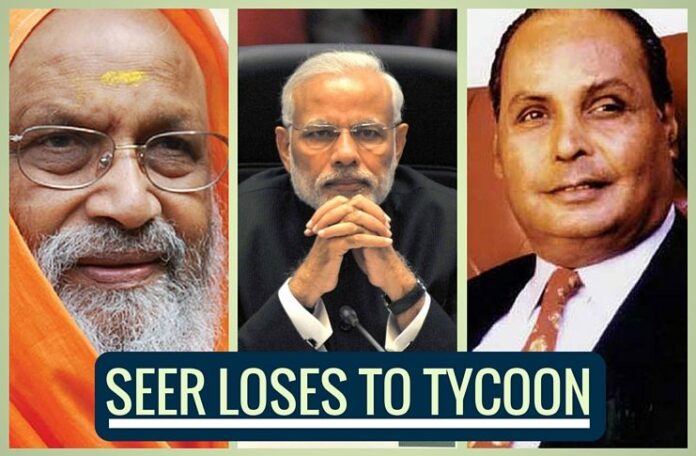
New Delhi
[dropcap color=”#008040″ boxed=”yes” boxed_radius=”8px” class=”” id=””]“M[/dropcap]y opinion on Padma Vibhushan for Ambani. Bharatratna escaped him in 2002. I wrote against the idea. But Vibhushan became victim.” This explosive tweet by Sangh Parivar ideologue S Gurumurty on the choice of Dhirubhai Ambani for this year’s Padma Vibhushan also echoes the sentiments of several bigwigs of the Saffron contingent.
Few would have forgotten that Dayananda Saraswati was the spiritual guru of Prime Minister Narendra Modi…
Known for his no-nonsense approach, Gurumurty has come out with another tweet to question what goes behind the Padma awards.
“In Padma awards some names add value to the awards and some names bringing disrepute to the awards. Yet the craze for this award is shocking,” he said.
Talking to several leaders of the BJP and its ‘Parivar’ one got the distinct impression that most of them were upset with the way the government relegated Swami Dayananda Saraswati behind Ambani by conferring on him Padma Bhushan award, a notch below Padma Vibhushan.
[dropcap color=”#008040″ boxed=”yes” boxed_radius=”8px” class=”” id=””]F[/dropcap]ew would have forgotten that Dayananda Saraswati was the spiritual guru of Prime Minister Narendra Modi, who visited his ashram in Rishikesh on September 11 last year, just two weeks before the Saint breathed his last on September 23. On His death Modi tweeted, “Swami Dayananda Saraswati ji’s demise is a personal loss. I pray that his soul attains eternal peace.”
By bestowing on Dhirubhai Ambani greater honor than Swami Dayananda Saraswati, the government has let itself open to criticism that though it is not tired of talking about reviving India’s spiritual traditions, yet it lacks the sensitivity to honor a man who dedicated his entire life in preaching Vedanta philosophy and taking it to the masses.
Born on August 15, 1930, Dayananda Sarswati was a teacher of Advaita Vedanta, and founder of the Arsha Vidya Gurukulam.
According to the website of the Dayananda Saraswati ashram, www.dayananda.org, Swamiji has been teaching Vedanta in India for more than five decades and around the world since 1976. His deep scholarship and assimilation of Vedanta combined with a subtle appreciation of contemporary problems make him that rare teacher who can reach both traditional and modern students.
[dropcap color=”#008040″ boxed=”yes” boxed_radius=”8px” class=”” id=””]A[/dropcap] teacher of teachers, Swami Dayananda taught six resident in-depth Vedanta courses, each spanning 30 to 36 months. Four of them were conducted in India and two in the United States. Each course graduated about 60 qualified teachers, who are now teaching throughout India and abroad. Under his guidance, various centers for teaching of Vedanta have been founded around the world; among these, there are three primary centers in India at Rishikesh, Coimbatore, Nagpur and one in the U.S. at Saylorsburg, Pennsylvania. There are more than one hundred centers in India and abroad that carry on the same tradition of Vedantic teaching.
In addition to teaching, Swami Dayananda has initiated and supported various humanitarian efforts for the last forty-five years. The most far-reaching of these is the establishment of All India Movement for Seva in 2000. Awarded consultative status with ECOSOC (Economic and Social Council) by the United Nations in 2005, this organization is devoted to serving people in the remote areas of India, mainly in the field of Education and Health Care.
[dropcap color=”#008040″ boxed=”yes” boxed_radius=”8px” class=”” id=””]S[/dropcap]wami Dayananda Saraswati has also promoted several international events and participated as a speaker in several global forums, among which are: the United Nations gathering of NGO’s, the UNESCO Seoul Global Convention, the United Nations 50th Anniversary Celebration, the Millennium World Peace Summit, the International Congress for the Preservation of Religious Diversity, the Conference on the Preservation of Sacred Sites, the World Council for Preservation of Religious Diversity, the Youth Peace Summit, the Global Peace Initiative of Women Religious and Spiritual Leaders, a Hindu-Christian dialogue with the World Council of Churches, and the Hindu-Jewish Leadership Summit.
On the other hand, Dhirubhai Ambani will be remembered as the founder of one of the most powerful and wealthiest corporate empires and an author of a real life tale of rag-to-riches story. But history will also judge him as a man who had few scruples and even lesser business ethics.
He mastered the art of remaining on the right side of the ruling dispensation at the centre. The list of top politicians who ate out of his hand is long — long enough to include some of the most venerable names; long enough to include decision makers and party poopers; long enough to expose the dark underbelly of India’s corrupt bureaucracy and yellow journalism.
[dropcap color=”#008040″ boxed=”yes” boxed_radius=”8px” class=”” id=””]T[/dropcap]he legacy he left behind has dogged his sons as well. Whether it is Reliance Communication’s alleged involvement in the 2G scam or the controversy surrounding irregularities in allotment of 4G license to big Brother Mukesh Ambani’s Reliance Industries, or the gas pricing row, Reliance has always been dogged by one after another controversy.
Remembering Dhirubhai Ambani, well-known journalist Paranjoy Guha Thakurata said the following in an article titled The two faces of Dhirubhai Ambani…
“When he (Dhirubhai Ambani) died, the Reliance group of companies that Dhirubhai led had a gross annual turnover in the region of Rs 75,000 crore or close to US $ 15 billion. The group’s interests include the manufacture of synthetic fibres, textiles and petrochemical products, oil and gas exploration, petroleum refining, besides telecommunications and financial services. In 1976-77, the Reliance group had an annual turnover of Rs 70 crore. Fifteen years later, this figure had jumped to Rs 3,000 crore ($600 million). By the turn of the century, this amount had skyrocketed to Rs 60,000 crore ($12 billion). In a period of 25 years, the value of the Reliance group’s assets had jumped from Rs 33 crore to Rs 30,000 crore ($6 billion).”
[dropcap color=”#008040″ boxed=”yes” boxed_radius=”8px” class=”” id=””]T[/dropcap]he textile tycoon’s meteoric rise was not without its fair share of controversy. In India and in most countries of the world, there exists a close nexus between business and politics. In the days of the licence control raj Dhirubhai, more than many of his fellow industrialists, understood and appreciated the importance of ‘managing the environment’, a euphemism for keeping politicians and bureaucrats happy. He made no secret of the fact that he did not have an ego when it came to paying obeisance before government officials – be they of the rank of secretary to the Government of India or a lowly peon.
Long before Dhirubhai entered the scene, Indian politicians were known to curry favour with businessmen – licences and permits would be farmed out in return for handsome donations during election campaigns. The crucial difference in the business-politics nexus lay in the fact that by the time the Reliance group’s fortunes were on the rise, the Indian economy had become much more competitive. Hence, it was insufficient for those in power to merely promote the interests of a particular business group; competitors had to simultaneously be put down. This was precisely what happened to the rivals of the Ambanis.
Further in his article Thakurta goes on to state: “1986 was a crucial year for Dhirubhai. He suffered a stroke in February that year. A few months later, the Express began publishing a series of articles attacking the Reliance group as well as the Indira Gandhi regime for favouring the Ambanis. These articles were coauthored by Arun Shourie who, ironically, as Union Minister for Disinvestment in the Atal Behari Vajpayee government, presided over the sale of 26 per cent of the equity capital of the former public sector company, Indian Petrochemicals Corporation Limited (IPCL), to the Reliance group in May that year. By gaining managerial control over IPCL, the Reliance group would now be able to dominate the Indian market for a wide variety of petrochemical products.”
[dropcap color=”#008040″ boxed=”yes” boxed_radius=”8px” class=”” id=””]S[/dropcap]hourie’s co-author for the famous series of anti-Reliance articles was Chennai-based chartered accountant S. Gurumurthy who happens to be a leading light of the Swadeshi Jagaran Manch, an outfit that espouses the cause of economic nationalism and is closely affiliated to the Rashtriya Swayamsevak Sangh (RSS), the ideological parent of the ruling Bharatiya Janata Party (BJP). The Express articles written by Shourie and Gurumurthy meticulously detailed a host of ways in which the government of the day had gone out of its way to assist the Ambanis. One article was on the subject of how the Reliance group imported ‘spare parts’, ‘components’ and ‘balancing equipment’ of textile manufacturing machinery to nearly double its production capacities. The article provocatively claimed the Ambanis had ‘smuggled’ in a plant.
Another story detailed how companies registered in the tax haven, Isle of Man, with ridiculous names like Crocodile Investments, Iota Investments and Fiasco Investments had purchased Reliance shares at one-fifth their market prices. Curiously, most of these firms were controlled by a clutch of nonresident Indians who had the same surname, Shah. Though Pranab Mukherjee had to change a reply he gave in Parliament on the investments made by these firms, an inquiry conducted by the Reserve Bank of India could not find any evidence of wrongdoing. Yet another article detailed how the group had been the beneficiary of a ‘loan mela’ – a number of banks had loaned funds to more than 50 firms that had all purchased debentures issued by Reliance Industries.
Looking at the life and legacy of both Dhirubhai Ambani and Swami Dayananda Saraswati, many would tend to think that it would have been better had the government not honored the seer if he was to be demoted behind a controversial business tycoon!
Note:
1. The conversion rate used in this article is 1 USD = 50 Rupees.
- Subramanian Swamy approaches Supreme Court on Govt’s modification of 2G Scam Judgment to avoid auction of Satellite Spectrum - April 23, 2024
- Defence Minister Rajnath Singh visits Siachen. Reviews military preparedness - April 22, 2024
- Amit Shah’s shares in the Stock Market almost doubled in the past five years - April 21, 2024











These bjp guys are making fools of people who voted for them.Modi being a party to the decision of giving padma Vibhushan to ambani has signaled that crooks within India should prosper in the same way they did during crooked UPA regime.